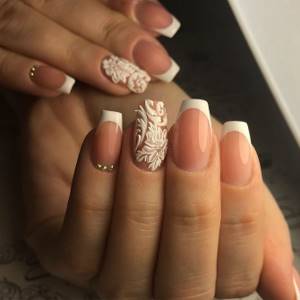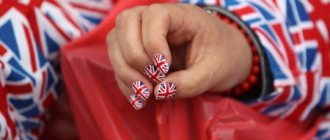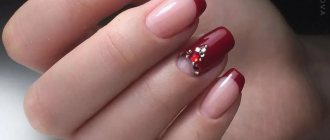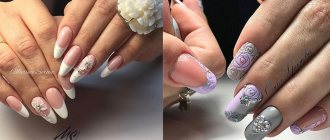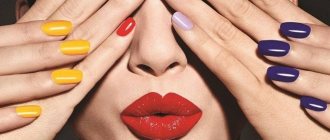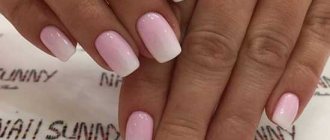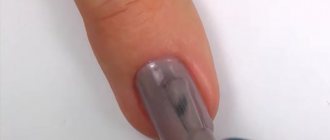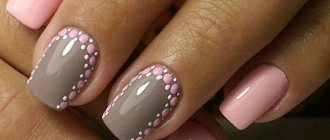Volumetric sculpting on nails amazes with its beauty and grace, but scares novice nail artists with the seeming complexity of execution. This type of decor really has many nuances. But even a novice master can master the process of creating beautiful three-dimensional figures and get the result desired by the client. What are the features of 4D modeling and how to do it correctly and aesthetically? This is what we will talk about today.
Gels for modeling. Types, functions, purpose
The most commonly used materials for three-dimensional design modeling are 3D, 4D gels, as well as sculptural ones. They have the following nuances:
3D: differs from classic gel in a denser and more flexible structure. This is what is chosen for baguette (frame) modeling.
4D: has a dense texture, similar to hard plasticine. Modeling with it is performed in conjunction with a cleanser (a specialized liquid for cleaning brushes) to treat the brush (dotsa), since the gel sticks to the tool and hands during work.
Sculpted: used to create artificial nails. These materials are viscous and cannot self-level. They require sanding with a file to level the surface, but do not need to be subsequently secured with a finishing coat.
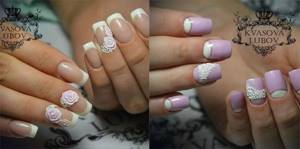
At the moment, the development of manicure techniques is aimed at simplifying work with any material. And it is 4D gels that are the type of decor that is most simple, easy and understandable to work with, even for self-taught craftsmen. The technique of working with this dense mass that holds its shape perfectly is developed quickly. And the finished figures amaze with their stylish and spectacular execution, no worse than in an expensive salon. In order to create luxurious designs at home yourself, you need to know all the intricacies of gel plasticine. Namely…
How to create a three-dimensional design on gel polish?
To create a 3D design on gel polish, you will need a special material - gel plasticine . It has special properties of density and ductility, which allow for volumetric modeling. Such gel plasticine can already be found from different manufacturers: Arnelle, Vogue Nails, Lady Victory, Koto, and you can even order “Noname” 3d gel in Chinese online stores. Next, I will tell you how to use it using the Vogue Nails brand as an example.
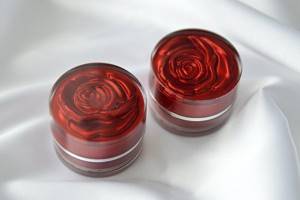
Gel plasticine from Vogue Nails is available in two main colors: black and white, but this is not a problem, since after polymerization you can always apply colored gel polish to it, thus changing the color to the desired one. The container is decorated with the signature Vogue Nails rose under translucent red plastic, it looks very stylish! The color inside can be easily determined by the signature on the bottom of the container. The Vogue Nails gel plasticine itself is very viscous and mega thick, so it is better to scoop it up with metal tools: a manicure spatula or a dots dot.
The most popular options for volumetric 3D design from gel plasticine on gel polish are lace and various flowers . In this article I will show you the first design option, and later I will definitely introduce you to the second.
Volumetric design: advantages of using 4D gel
The new generation of gels for nail design, as an alternative to classic acrylic sculpting, has many advantages in operation.
1. They allow you to create any figure, slowly, carefully and accurately working out the details. This material does not dry instantly in the air and does not spread over the nail like water. That is why this is the best “training” product for those learning the basics of nail art.
2. Since the creation process is quite time-consuming, the master doing the modeling (and his model as well) will certainly appreciate such a bonus as the absence of a pungent odor. If you need to sculpt fragile elements, it is also convenient that you can make the thinnest parts without spoiling the material. With this approach, the illusion of glass decor, as if glowing from within, is achieved.

3. The newest gels allow you to create jewelry that does not cling to clothing or hair with sharp tips and edges. 4D decor is stronger and more durable, resistant to external influences, mechanical and chemical damage, and not susceptible to chipping or color fading. The other side of the coin is the need to carefully and accurately file away a dense pattern without damaging natural nails.
4. Plasticine gels create maximum scope for creativity and flight of fancy. They can create both ultra-thin and textured shapes (up to 5 mm thick). And the texture itself perfectly accepts any third-party decor: rhinestones, rubs, pigments, sparkles, glitter, stones, shells, mica, mother-of-pearl. 4D nail gels also mix well with each other to create new unique shades. And even in one image they are combined with acrylic and shellac. You just need to supplement the main design product with decorations sparingly, so as not to excessively lengthen the polymerization process of the finished manicure.

Acrylic sculpting on nails: features of manicure
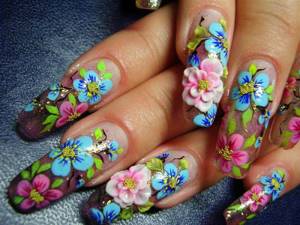
Acrylic modeling has been pleasing women with its unusual design for decades. The acrylic extension system consists of powder and liquid (monomer).
The combination of these two materials occurs directly at the moment of building up or creating a three-dimensional design.
Acrylic powder can be colored, transparent, translucent, or contain glitter. A wide range of powder colors allows you to create bright designs to suit every taste.
Types of acrylic modeling:
- Aquarium sculpting involves the presence of a three-dimensional design inside an artificial nail. First, decorative acrylic elements are placed on the nail, and then the design is filled with a transparent acrylic layer. The advantage of this type of sculpting is that the nails do not cling to clothing; the disadvantage is that the nail plate is too thick.
- Volumetric acrylic sculpting on nails is a more popular option. Nails look as natural as possible, and the volume of the design is perceived very clearly. The disadvantage can be considered inconvenience in everyday life due to protruding elements that cling to fabrics.
We recommend: Gradient on nails: how to choose the right combination of colors
What you will need for acrylic sculpting:
- flat brushes for modeling;
- liquid;
- acrylic powder of different colors;
- napkins;
- decorative elements, glue.
How to prepare your nail?
Similar to gel, acrylic modeling is performed on extended nails (gel, acrylic) or coated with gel polish.
Step by step technique:
| Step 1 Prepare your nails for creating a composition with acrylic (extension or cover with a layer of gel polish). |
| Step 2 Dip a thin brush in liquid and dip it into a container of acrylic powder. Twist the brush so that a small lump forms on it. |
| Step 3 Place the lump on the nail plate in the place where the design element will be formed. Use a brush to straighten the lump, creating a three-dimensional fragment of the composition. If it dries out, soak the brush in liquid and continue working. |
| Step 4 Repeat for the rest of the drawing. |
| Step 5 If desired, glue decorative elements: beads, rhinestones. |
| Step 6 Acrylic sculpting is usually not given a topcoat unless it is an aquarium design. But some masters cover the nail plate with a top gel layer and dry it in a UV lamp. Thus, the volumetric pattern acquires a glossy shine. |
Gel plasticine: features of performing and wearing volumetric manicure
In order to remain completely satisfied with this product, during the design process you need to remember and follow a few simple rules.
- Depending on the thickness of the figure, each created element of the composition must be dried separately in a UV or LED lamp for at least three to four minutes. In this case, during the laying out process, extreme care must be taken so that individual parts of the pattern do not merge with each other during polymerization.
- A degreaser will serve as an eraser to correct unevenness of a particular element. The alcohols in its composition will make the gel more plastic. However, you are not limited in the number of correction attempts. Because without baking (even in direct sunlight or a bright lamp on the table), the 4-D gel will not harden.
- Maintaining hygiene during the sculpting process will allow you to achieve an ideal result. Wash your hands thoroughly before creating decor. And treat the fingertips that you will use to knead and form the gel with a cleanser. If the master is used to working with gloves, their surface must also be thoroughly cleaned and degreased. Any foreign particles and dust can spoil the color of the sticky 4-D gel.
- When choosing a tool for work, give preference to a hard silicone brush, plastic stick or dotsu, as a soft brush will not provide enough pressure for sculpting.
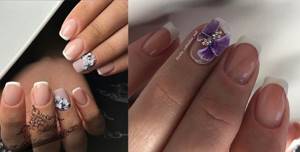
- If your painting consists of gels of different shades, then they should be polymerized one by one. And before drying, do not forget to check whether you have painted the ends of the free edge. Otherwise, your manicure, when examined closely, will not look as perfect as you want.
- A pleasant surprise of the new generation of gels is that they are absolutely not capricious when drying. Even the high density of the product and the hiding power of the color do not affect the quality of drying in the lamp. Manicurists did not report cases of incomplete baking or other problems.
- When resorting to modeling as decoration, observe moderation. An abundance of decor will not decorate your manicure. For a particularly important event, it is more appropriate to resort to such decor as an accent, for 1-2 fingers.
- Volumetric modeling is not the best companion for a beach holiday or everyday manicure, even despite its strength. If you still really want to decorate your nails in this way, place the sculpt on the nail according to safety rules.
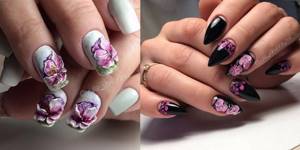
Secrets of working with gel plasticine
- If, in addition to volumetric modeling on gel polish, any design is planned, then it must be done initially, since gel plasticine is applied to a ready-made coating with a finishing top.
- In the process of laying it on nails, plasticine periodically sticks to the blade, so it needs to be cleaned. To do this, it is convenient to use liquid to remove the dispersion layer.
- When distributing it on the nail, it is convenient to first make a small ball and then roll it into the desired shape. It is very flexible, so all flaws can be easily corrected with a flat brush dipped in liquid.
- You should not allow liquid to get on the already laid material: this makes it more viscous, and difficulties arise with the formation of the pattern.
- When making flowers on lace, be sure to lead the petals from the center of the flower: this is how they acquire the correct shape.
- To get a clear outline, dot the dots in one place several times. Adjacent areas may shift and may need to be adjusted.
Personally, I immediately wanted to try this gel as soon as I saw photos of voluminous lace on the Internet. It's fresh, original and very beautiful! The technique of using it is quite simple at first glance, but it also requires some practice in order to ultimately get the perfect sculpt. I'd love to hear your comments on this design. And that's all for me, see you soon!
Design materials provided by the online store krasotkapro.ru
White manicure with modeling
Another stylish option for manicure that will suit any combination of clothes and accessories is the use of white varnish. Any fashionable design based on this color will look advantageous and flawless. Add to this delicate and sophisticated version elements of a three-dimensional pattern in the same color, and your hands will be complemented with grace. It is only important that the composition does not merge with the general background. To avoid such a nuance, complement your manicure with pearl rub. A fashionable solution would be floral modeling on a white background. Stylists recommend making beautiful buds or compositions with a two-finger stretch, and choosing pastel or contrasting shades. The pattern of a “knitted” fabric in dim embossing will also be a very appropriate and original idea.
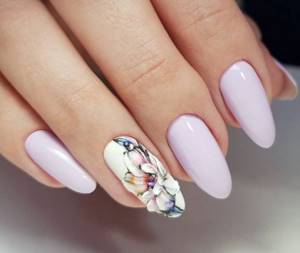
French manicure with sculpting
French manicure has long become the standard of classics for many fashionistas. It is universal, and thanks to the variety of decor options, it remains in demand for daily use and for special events and holidays. We invite you to get acquainted with one of the original French modeling manicure decors. Volumetric and textured patterns go well with French notes and look beautiful on a transparent base with a white tip. Light shades in the design are very appropriate for a light and romantic look. If you want to add a catchy accent to your manicure, make voluminous designs in a more saturated color and give preference to a different shade of nail coating and the color of your smile.
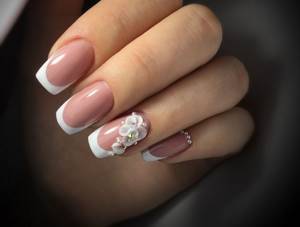
Wedding manicure with sculpting
This technology of performing manicure in the wedding look of the bride and guests of the celebration is considered popular. A common option is considered to be a classic French jacket with modeling in light, preferably white, colors. An alternative and no less beautiful option would be a lunar design with sculpting. In addition to textured openwork abstractions and voluminous floral motifs, on a neutral background, you can add rhinestones and pearls. In this option, pastel-colored varnishes will be successful in combination. For the bride's image, it is enough to decorate only the ring fingers with airy flowers or hearts, which will add elegance and sophistication to her hands. Pearl rub will make your nails shine and look simply gorgeous. Guests are allowed to use modeling elements in brighter shades, but do not overdo it with texture and color. Such compositions, unfortunately, look better in the style of minimalism.
